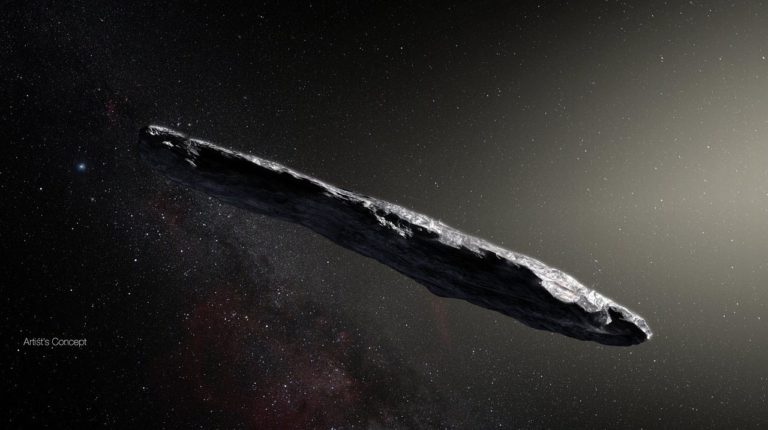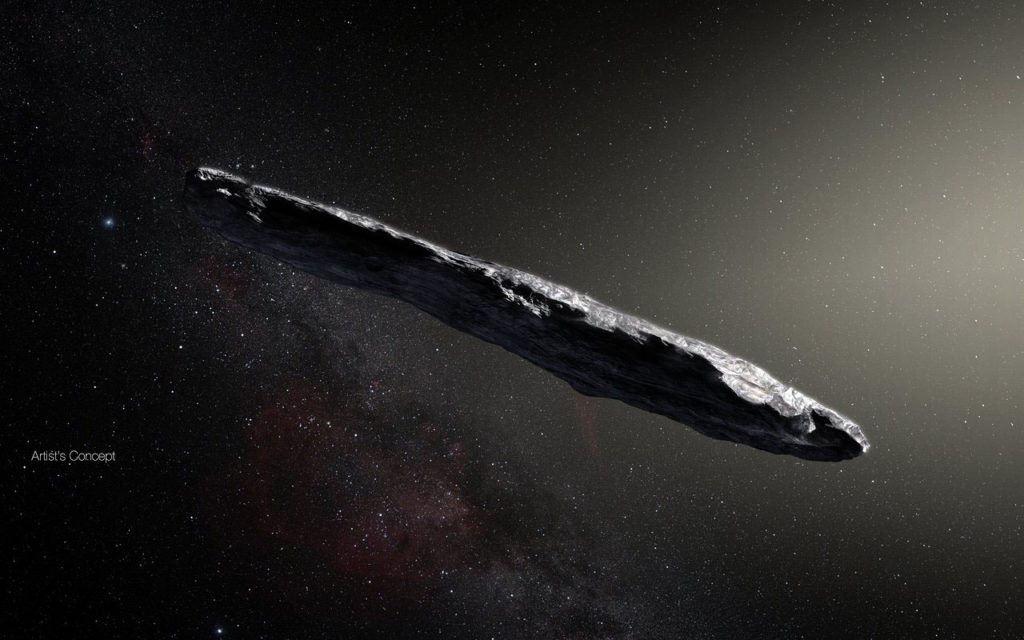The Oumuamua Spaceship; Interstellar Asteroid or Alien Probe?

Two months ago, a cigar-shaped object sped past Earth at an incredible rate, before being catapulted to the outer reaches of the solar system by the Sun’s gravitational pull. This asteroid-like object was given the name Oumuamua and is now being carefully tracked to pick up any frequencies it might be emitting and find out more about this strange artifact.
The Alien Asteroid
On October 19th of this year, Robert Weryk spotted an asteroidal object zipping through the solar system at a rate of 196,000 mph. Weryk was using the Pan-STARRS telescope at the Haleakala Observatory in Hawaii, hence the vowel-heavy Polynesian name, Oumuamua.
Oumuamua means scout, to “reach out first” or “reach out in advance.” Weryk says he sees the asteroid as a messenger from the past that is reaching out to us.
At first, it was thought that Oumuamua was a comet, though it was quickly reclassified due to its lack of a cometary tail, but was soon reclassified again due to its odd shape and provenance, possibly coming from the star Vega in the Lyra constellation. This interstellar object, being the first of its kind ever observed, was given a unique classification with the name 1I/2017 U1, a.k.a. Oumuamua.
Oumuamua is several hundred meters in length, with its height and width about a tenth of that. Its odd structure is fitting for interstellar travel and is a shape that scientists believe would be ideal for interstellar spacecraft. The cigar-shape minimizes friction and damage from interstellar gas and dust, preventing collisions that large, round asteroids would be more susceptible to.

nasa.gov
Though most astronomers assume that it is simply an icy asteroid, careering through space on a 600,000-year journey from Vega, others believe it is worth looking at a little more closely for evidence of extraterrestrial life.
This is where the Breakthrough Listen project got involved, when they pointed the Green Bank Telescope at it for a 10-hour period to pick up any radio frequencies or anomalies.
The program, funded by Russian billionaire Yuri Milner, in coordination with Stephen Hawking and the SETI program at UC Berkeley, devotes satellite power to listening for extraterrestrial life in the universe.
Though they’re not getting their hopes up with Oumuamua, they believe it to be worthwhile, and whether or not it turns out to be a spaceship, artifact, or psychic monolith, like the one in Arthur C. Clarke’s Space Odyssey, Breakthrough Listen believes it can at least glean some useful information on this cosmic phenomenon.
After pointing the Green Bank Telescope at Oumuamua, scientists don’t believe to have discovered any signals, though some believe it could have triggered an “awakening” of the extraterrestrial entity from which it originated. This is according to Nick Pope, the former head of the Ministry of Defense for the UK.
Scientists are still intrigued by the composition of the asteroid, as it appears to have a strange organic coating around it, possibly protecting its inner composition. Normally asteroidal objects like these are composed of ice and rock, leaving a trail in their wake, especially when it comes within close proximity to a star.
Oumuamua came particularly close to the Sun, yet it emitted no tail and continued its journey at a mercurial speed out towards the edge of the solar system.
According to scientists who were able to catch a quick glimpse, Oumuamua consisted of minerals and alloys not found in our solar system, adding to its mystique.
Scientists are Still Puzzled
With Oumuamua on a fast trajectory out of the solar system, scientists must act quickly to study it. By May of 2018, it will be on its way past Jupiter as it is currently moving at a rate of 58,160 miles per hour.
Oumuamua’s shape and speed aren’t the only characteristics that have puzzled scientists. Its dark red color, reflecting only 4 percent of sunlight, seems to vary in color as scientists observe it. Looking at it under infrared light, scientists noticed it was grey in color, typical for an icy body that we’ve seen more locally, though it didn’t emit the tail normally seen with icy asteroids and comets.
Some are drawing the eerie connection to the Arthur C. Clarke novel, Rendevous with Rama, in which a cylindrical alien spaceship enters our solar system, originally mistaken for an asteroid. The similarities between Oumuamua and Rama are uncanny, with the sci-fi asteroid coming in on a fast trajectory from interstellar space, rotating rapidly to create a gravitational field for its inhabitants inside.

Oumuamua’s rotation has been calculated to once every 8 hours, while Rama rotated once every 4 minutes. But these technicalities haven’t prevented the Breakthrough Listen and other hopefuls from attempting to capture some type of signal from it.
Scientists have even suggested the possibility that we may catch up to Oumuamua with the Space-X BFR that is being developed for a manned mission to Mars. For this to be feasible though, the rocket would have to be completed and launched within the next five years.
There have been other ideas for catching up with Oumuamua by companies interested in mining asteroids as well as those who simply want to study them. Deploying a series of small probes to the interstellar object was another possibility. The Breakthrough Starshot project has proposed this concept in its search for alien life, though they have yet to develop a practical prototype.
This past August, Breakthrough Listen discovered a series of fast burst radio signals or FRBs coming from a distant dwarf galaxy, similarly perplexing scientists. Is this project on the cusp of discovering definitive proof of extraterrestrial life?
Nemesis Star Theory; Does the Sun Have an Evil Twin?

Many people remain anxious about the threat posed from a hidden nemesis planet, known as Nibiru, that has been prophesied to collide with Earth. Though many of the proposed dates for this collision have come and gone, there is another celestial body that may be more likely to lead to an apocalyptic event: The Nemesis Star.
The Nemesis Star Theory
Binary star systems occur frequently and are actually more common than single stars. At least that’s what we thought, until a recent hypothesis proposed the possibility that every star starts out as a binary pair or multi-pair system. While the theory hasn’t been confirmed, there is significant evidence that our Sun likely has a twin, an evil twin.
The majority of stars in the galaxy are red dwarfs, which are a fifth of the size of the sun and up to 50 times fainter. These types of stars are pretty commonly paired with another star in a binary system, leading astronomers to believe that Nemesis would be the Sun’s red dwarf star companion. But due to the small size and faintness of these stars, they can be hard to find, making Nemesis all the more elusive.

binary stars courtesy wired.com
This star is thought to be responsible for 12 cyclical extinction events on Earth, including the one that killed the dinosaurs. The Nemesis Star Theory’s roots can be traced to two paleontologists, David Raup and Jack Sepkoski, who noticed that there was a periodicity to major die-outs throughout Earth’s history, occurring in 26 million year intervals. This led to a number of astrophysicists and astronomers, postulating their own Nemesis Star hypotheses.
So how would the sun’s twin be responsible for mass extinctions? The Nemesis Star Theory proposed the idea that the Earth’s binary twin must be in a large 1.5 light-year orbit, retaining just enough gravitational pull between it and the Sun so as not to drift off. But the issue with the orbit of Nemesis is the possibility that it occasionally passes through a cloud of icy debris on the fringe of our solar system, known as the Oort Cloud.
Don’t Perturb the Oort
The Oort Cloud is a theoretical sphere that is believed to orbit our solar system, consisting of planetesimals, the small icy building blocks of planets, comets, and asteroids. These planetesimals are sticky and collide with each other until they become large enough to have a significant gravitational pull, eventually becoming as large as a moon or a planet. They also create asteroids and comets which can be knocked out of orbit and sent hurtling toward the center of the solar system, crashing into planets.
There is a binary star system that once passed close enough to nearly perturb the Oort, and it was likely visible from Earth. Scholz’s Star made a flyby some 70,000 years ago, at a distance of 50,000 astronomical units (AU), with one AU being the distance from Earth to the Sun. The Oort is thought to extend from anywhere between 5,000 and 100,000 AUs and is believed to contain up to two trillion celestial objects. Astronomers are 95% certain that Shulz’s star passed within half of a light-year of us, possibly perturbing the Oort, though apparently not enough to cause a mass extinction event.
Comets are believed to exist within the Oort and are the product of a thief model, a give-and-take of celestial bodies between stars when they’re formed. In this process, comets get pulled back and forth between the gravitational field of stars. It was for this reason that the Oort was theorized, due to the number of comets coming from it, there had to have been a sibling star that pulled them out to the Oort.

The Oort courtesy of space-facts.com
Astronomers also found a dwarf planet in the Kuiper Belt, a region just before the Oort that also contains icy, celestial bodies. This planet, named Sedna, orbits the Sun in a long, drawn-out elliptical path and is one of potentially hundreds. Sedna may help to explain the Nemesis star theory, in that its far-flung orbit was likely caused by our Sun’s twin, pulling it out as it drifted off into the depths of space. Imagine if instead of 9 planets in our solar system, there were a few hundred?
So where is this Nemesis star? Several years ago, the E.U. launched the wonderfully named, Gaia satellite, to map out the stars in the Milky Way and look specifically at stars that have had a close encounter with our solar system or that might come close in the future. But whether or not Nemesis will be found is unknown; it’s possible that it could make a return for the next mass extinction, or it is possible that it drifted off, perturbing the Oort of another star.




































